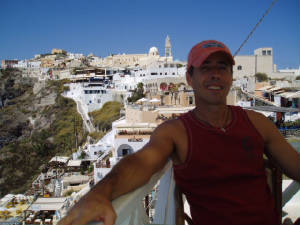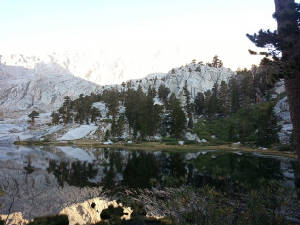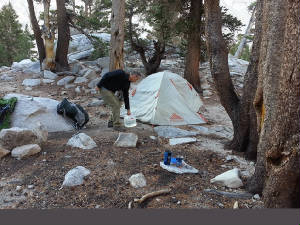The first location for the tent stake was no good because the
decomposed granite soil was too loose, and now the second spot we chose was already home to a submerged rock. The third spot
was a charm. The stakes had to be well-seated because the cold wind was howling down off the mountain and it was just mid-day.
The nylon fluttered helplessly like a flag assaulted by endless gusts. We gathered rocks and piled them to build a wall to
offer relief to our base camp tent against the biting air. Shelter is critical to survival at the 12,500 foot elevation of
Trail Camp, and we were still a long way from the summit of Mount Whitney. It was September 28, 2013.
Barry and I had been climbing since daybreak, after spending
the night at 10,000 feet at the portal in an effort to acclimate to the extreme altitude of the monster rising above us. The
sun struggled to clear the rugged landscape, and shadows shrank slowly. Our lungs resisted the thin, chill autumn mountain
air. We shed our warmer clothing as the morning wore on. The trail rose constantly, with very few breaks. Around every blind
turn, we hoped for a level area, but it rose again and again. We knew the kinder aspen and pine forest hiking would soon give
way to the harsh rocky terrain above timber line, which would lead us to Trail Camp, where I collapsed in exhaustion. I thought
my legs would take me no further, but the sight of the clear blue alpine waters of Consultation Lake rejuvenated me for the
chore of raising our tent at Trail Camp.
Time was not on our side. We contemplated waiting
‘til morning to advance upon Mount Whitney peak, but the weather was worsening. We quickly stowed our gear in the tent
and launched our assault on the summit. The 99 switchbacks before us lived in infamy. Shear thousand-foot cliffs dropped away
from the trail, and wind taunted us. A stretch of snowy trail glistened with blue ice, forcing us to drop to all fours, or
risk falling and sliding toward the edge of a dizzying abyss. The final switchback gave way to Trail Crest at 13,700 feet
with its astonishing views to the west, the Ansel Adams Wilderness and the John Muir Trail. Majestic Peaks and verdant meadows
with shimmering lakes teased us to stay, rest, and inhale their intoxicating beauty, but several miles of rugged terrain lie
ahead on our quest to the Whitney Summit.
Onward we trudged, past “The Windows”
with their panoramic views, and stealthily along narrow ledges adjacent to sheer cliffs that dropped away to the valley floor
far below. The three “Needles” thrust themselves eastward above us at over 14,000 feet each, and before us now
lie the traverse on the backside of the mountain, with its relentless obstacle course of boulders. Fatigue and altitude sickness
tormented us as we pressed forward with our venture. Each step was a challenge that demanded physical and mental focus, and
our breathing was labored as we gasped for air, painfully forward.
It stunned us. Despite the many photos and writings we had carefully
viewed and meticulously read, the Whitney Summit, with its mesmerizing presence and awe inspiring views took our remaining
breath away. Speechless, we stared across the Earth laid out before us, at 14,505 feet she is the highest peak in the continental
United States.



